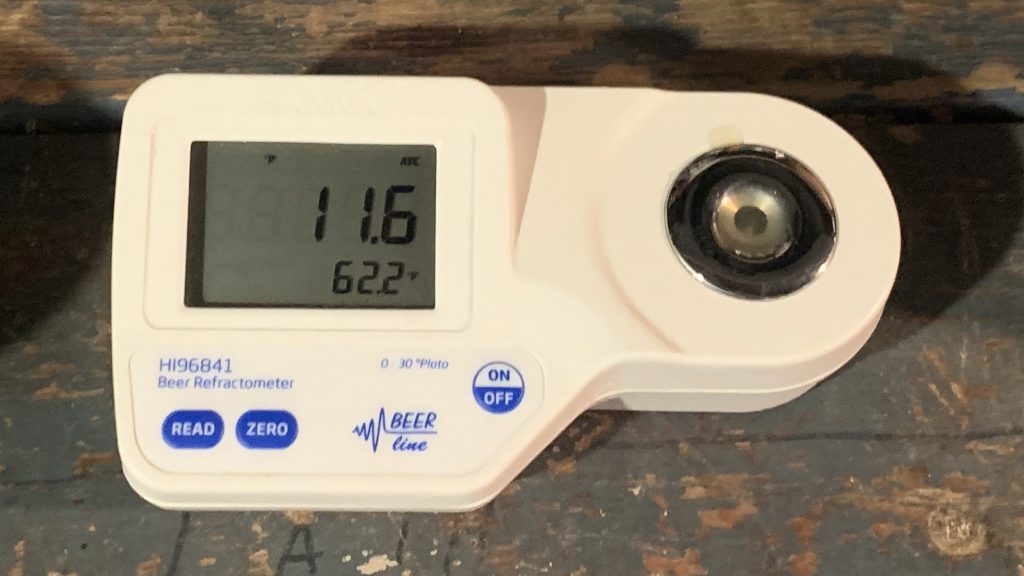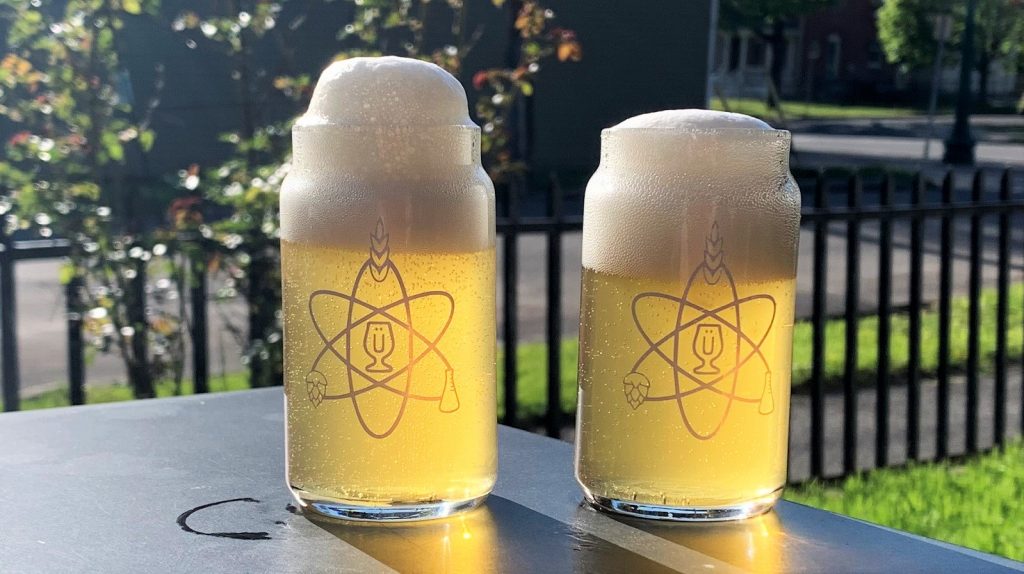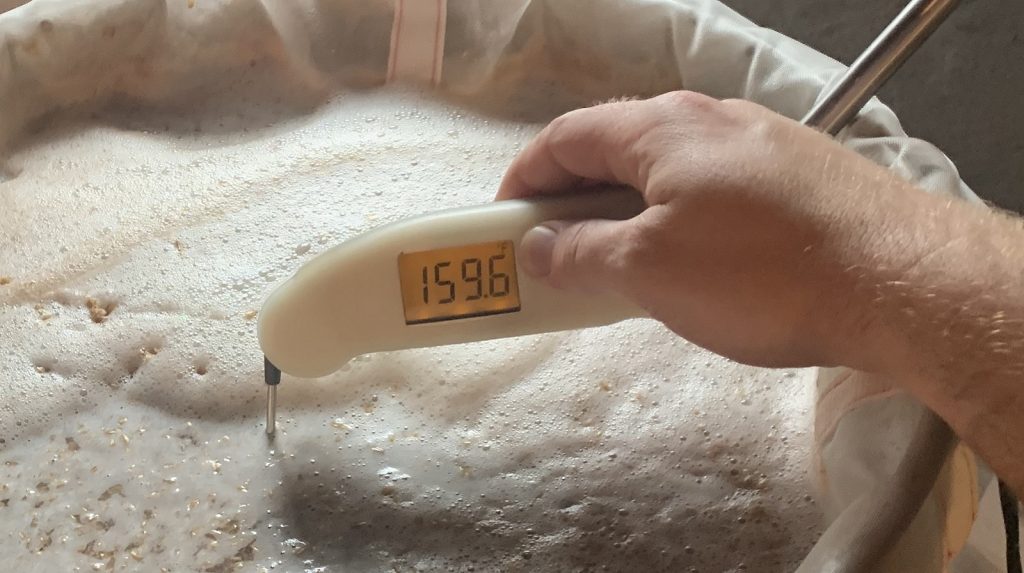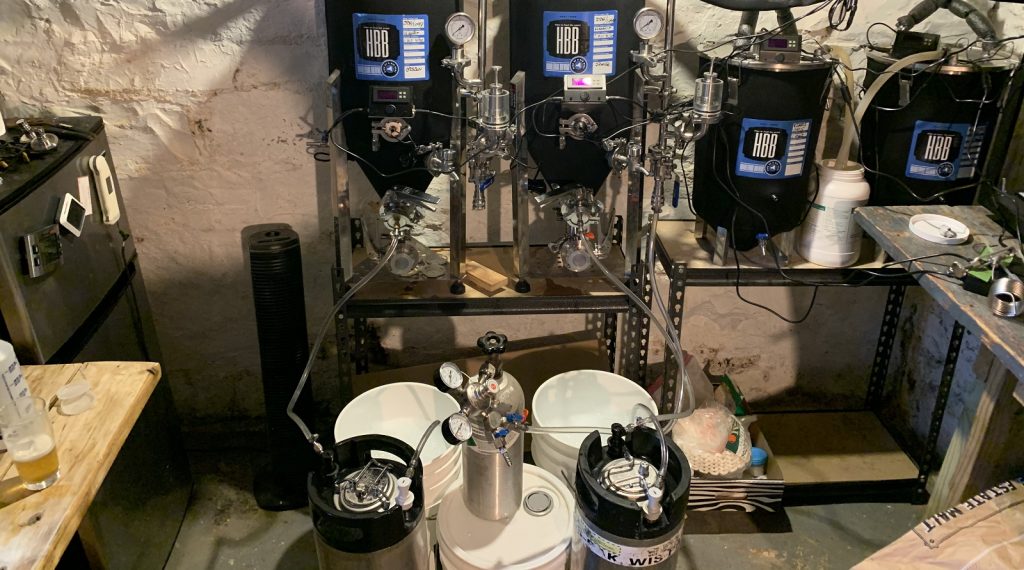Author: Phil Rusher
Hops are a defining feature in many American styles of beer and brewers have come up with myriad methods for imparting as much hop character as possible. Traditionally, hops were added to the boiling wort for various amounts of time, though over the last couple decades, it’s become commonplace to dose certain styles with a charge of hops at some point during fermentation to maximize aroma while limiting bitterness.
As the obsession for hoppy beers was skyrocketing, innovative brewers began developing novel practices they believed would increase the hop potency of their beer, one of which involves making two dry hop additions separated by a short period of time. Adopted by the marketing teams of many commercial breweries, so called double dry hopped (DDH) beers are sold as packing a stronger hop punch than their counterparts dry hopped just once despite using the same total amount of hops. The arguments for this generally center around contact time—by splitting the dry hops into 2 additions, compounds will be extracted at different rates, leading to a desirable difference.
In one past xBmt, tasters were unable to reliably tell apart an American IPA where all of the dry hops were added at once from one that was double dry hopped, suggesting the perceptible impact was minimal at best. I recently began to wonder if perhaps the impact of double dry hopping might be more noticeable in a less characterful style and decided to test it out on a simple American Pale Ale.
| PURPOSE |
To evaluate the differences between an American Pale Ale where the entire dry hop is added at once and one that is double dry hopped with the same amount of hops.
| METHODS |
My goal being to emphasize any differences caused by double dry hopping, I designed a relatively low OG American Pale Ale recipe for this xBmt.
Twice The Fun
Recipe Details
| Batch Size | Boil Time | IBU | SRM | Est. OG | Est. FG | ABV |
|---|---|---|---|---|---|---|
| 5.5 gal | 30 min | 47.5 | 5.4 SRM | 1.046 | 1.009 | 4.86 % |
| Actuals | 1.046 | 1.009 | 4.86 % | |||
Fermentables
| Name | Amount | % |
|---|---|---|
| Super Pale Malt | 6.25 lbs | 69.25 |
| Vienna | 1.375 lbs | 15.24 |
| Shaniko: White Wheat Malt | 1.125 lbs | 12.47 |
| Carapils | 4 oz | 2.77 |
| Black Barley | 0.4 oz | 0.28 |
Hops
| Name | Amount | Time | Use | Form | Alpha % |
|---|---|---|---|---|---|
| Hallertau Magnum | 10 g | 30 min | Boil | Pellet | 11.1 |
| Loral | 30 g | 10 min | Boil | Pellet | 11.5 |
| Simcoe | 30 g | 10 min | Boil | Pellet | 13.3 |
| Cascade | 30 g | 2 min | Boil | Pellet | 6.1 |
| El Dorado | 100 g | 9 days | Dry Hop | Pellet | 12.7 |
| Enigma | 56 g | 9 days | Dry Hop | Pellet | 17.5 |
| Medusa | 56 g | 9 days | Dry Hop | Pellet | 8.6 |
Yeast
| Name | Lab | Attenuation | Temperature |
|---|---|---|---|
| Flagship (A07) | Imperial Yeast | 77% | 32°F - 32°F |
Notes
| Water Profile: Ca 126 | Mg 0 | Na 29 | SO4 254 | Cl 86 |
Download
| Download this recipe's BeerXML file |
I made starters of Imperial Yeast A07 Flagship a couple days ahead of time.
On brew day, after collecting the water for a single 10 gallon batch, I weighed out and milled the grain.
With the water properly heated, I incorporated the grains then checked to make sure the mash was at my target temperature.
When the 60 minute mash rest was complete, I removed the grains and set my electric controller to heat the wort, at which point I prepared the kettle hop additions.
The wort was boiled for 30 minutes with hops added at the times listed in the recipe.
When the boil was completed, I chilled the wort and evenly split it between two sanitized Unitanks before taking a refractometer reading.

Next, I pitched the yeast starters into each batch then set my glycol chiller to hold both at 66°F/19°C.
Following 3 days of fermentation, I used sealed dry hoppers to add the entire amount of dry hops to one batch while the other batch received half the amount of every hop.
After an additional 3 days, I added the rest of the hops to the double dry hop batch using the same method.
Hydrometer measurements taken 3 days later, 6 total from the initial dry hop addition, showed both hit the same FG.

At this point, I dumped the trub and cold crashed the beers to 34°F/1°C, leaving them alone for a week of cold conditioning before pressure transferring them to CO2 purged kegs.
The filled kegs were placed in my keezer and burst carbonated overnight before I reduced the gas to serving pressure. After a week, they were carbonated and ready for evaluation.

| RESULTS |
Due to social distancing practices as a result of the COVID-19 pandemic, data for this xBmt was unable to be collected in our typical manner. As such, temporary adaptations were made involving the author completing multiple semi-blind triangle tests in as unbiased a way as possible.
Utilizing 4 opaque cups of the same color where 2 were inconspicuously marked, one set was filled with the single dry hop beer while the other set was filled with the double dry hop beer. For each triangle test, 3 of the 4 cups were indiscriminately selected, thus randomizing which beer was the unique sample for each trial. Following each attempt, I noted whether I was correct in identifying the unique sample. Out of the 10 semi-blind triangle tests I completed, I needed to identify the unique sample at least 7 times (p<0.05) in order to reach statistical significance. In the end, I correctly identified the unique sample 6 times (p=0.08), indicating my inability to reliably distinguish an American Pale Ale where the dry hops were added to the beer all at once from one where the same amount of dry hops were staggered in two doses.
As is often the case, I thought I perceived some slight differences in initial side-by-side comparisons of these beers, but once blinded during the triangle tests, I struggled to consistently tell them apart. Without question, these beers were far more similar than they were different, and both were pleasantly drinkable.
| DISCUSSION |
Dry hopping is a common method for imparting fresh hop character to beer, and over the years, as the popularity of the various types of IPA has risen, brewers have come up with unique spins on this method in hopes of maximizing hop pungency. One such approach involves making two dry hop additions at separate times, the idea being that different lengths of contact time with the beer will produce more desirable hop character. My inability to reliably distinguish a beer that was dry hopped a single time from one where the same amount of dry hops were split and added 3 days apart indicates any differences were small to be imperceptible to me.
The decision to use the same amount of dry hops for both batches in this xBmt was intentional, as the purpose was to test the claim the double dry hopping produces a beer with perceptibly different hop character than when making a single dry hop dose. While it’s possible these results can be explained by some other factor, the fact they corroborate those from a past xBmt suggests that splitting dry hop additions up may not have the effect many believe. It’s also possible the amount of dry hops used was enough to cover up any differences caused by making multiple additions, and that a smaller total usage rate would have been easier to distinguish.
I’ve made many batches of dry hopped Pale Ale, IPA, and even styles not traditionally known for being hoppy, most receiving a single dose, and I’ve rarely been disappointed with the hop character. Based on my experience with this xBmt as well as the non-significant results from a similar past xBmt, I’ll continue making single dry hop additions a few days into fermentation for the majority of beers, though when I’m aiming for over-the-top hop character, I might consider making multiple additions.
If you have any thoughts about this xBmt, please do not hesitate to share in the comments section below!
Support Brülosophy In Style!
All designs are available in various colors and sizes on Amazon!
Follow Brülosophy on:
FACEBOOK | TWITTER | INSTAGRAM
If you enjoy this stuff and feel compelled to support Brulosophy.com, please check out the Support page for details on how you can very easily do so. Thanks!






















15 thoughts on “exBEERiment | Single vs. Double Dry Hop In An American Pale Ale”
I daresay that there’s nothing innocent about me. /evillaugh
ftfy!
“I recently began to wonder if perhaps the impact of double dry hopping might be more noticeable in a less characterful style and decided to test it out on a simple American Pale Ale.”
“simple American Pale Ale”
-5 malts and 7 hops
I mean is this really a simple, “less characterful” beer than the one Marshall made last time this variable was tested?
To be fair, the grist was really just pale malt with Vienna and wheat for some extra malt character. The Carapils was added because I need to use up what I’ve got left of it while the black malt simply for foam positive effects and light color adjustment. Seems pretty straightforward and simple to me 😉 but I hear what you’re saying.
I’m sure it was a great beer! Just wondering then: if you consider this a simple pale ale, what is a non-simple pale ale for you?
Also, I don’t mean this in a critical way, but regarding the extra carapils, is the point of the exBEERiment to test a variable or to use up excess malts? I know you get this comment frequently, but wouldn’t the best test involve reducing confounding variables?
The general approach I take is to brew beers as the variable demands while brewing as I normally would, and part of me brewing as I normally would involves using ingredients so as to not waste anything. I think it’d be hard to say that the judicious use of Carapils here was confounding in any way.
I think it I would have preferred to see an exbeeriment to see if you could tell the difference between dry hopping with your fancy sealed dry hopper vs without.
It’s in the works!
Co-incidentally I built my own version of a sealed dry hopper without knowing one ever existed to buy until seeing it on your post. Used it for the first time last beer, thought I had come up with something novel, but guess not!
If anyone cares it’s probably cheaper to make your own out of stainless steel Tri clamp fittings than buy one. Simply assemble a 3″ butterfly, 3″ spool (or Tee as I explain below), disconnect gas in to TC along with a reducer and TC ball valve tap (or a PRV) at the top. Buy from China and your talking about £80/$120 all in and you have the flexibility of configuring it to your exact size/height.
One difference I came up with is to have the main body of the dry hopper as a tee instead of a spool (3″ wide but tees off to a smaller 1.5″ on the side). This is where I inject gas in. The vent (a ball valve tap instead of a ring pull PRV) is similarly placed at the top. The theoretical benefit of this configuration is that CO2 is pushed up from the bottom through the hop bed and out the top which ensures better mixing/purging of air than having input/output next to each other at the top. A silicone bung is placed in the tee entrance to prevent any hops hiding there when you drop the pellets, but that’s optional and probably not needed given the miniscule space.
I’ve always thought DDH mean doubling the amount of hops, regardless of how many addition steps where made.
There’s a lot of room for interpretation here and there’s no “standard” definition for the practice. In my mind, the term DDH is more marketing than anything and for the sake of maintaining consistency here we went with testing the timing instead of the mass of the hops used. On the surface it might be surprising if people couldn’t tell the difference between a beer that had a modest amount of dry hops from one with twice as much, but I can also imagine scenarios where that could happen. Perhaps there’s room for more xBmts here as well.
Would love to see an experiment comparing whirlpool and dip hop!
Greg did one of those a few years ago. This would be worth redoing in my opinion!
https://brulosophy.com/2016/02/29/hop-stand-vs-dry-hop-exbeeriment-results/
Hey, your exbeeriment, it’s amazing ! I just wonder about the temperature of the yeast in the details of the grist. You write 32F, like 0°C ?? Is it a mistake or I just don’t understand well ?
Yeah that’s a plugin issue with all of our recipes, sorry about that. The plugin will automatically say that the yeast strain’s preferred temperature is 32F and doesn’t take into account the actual temperature that we used. Here I fermented at 66F/19C.
All right no problem, tanks for your answers:)